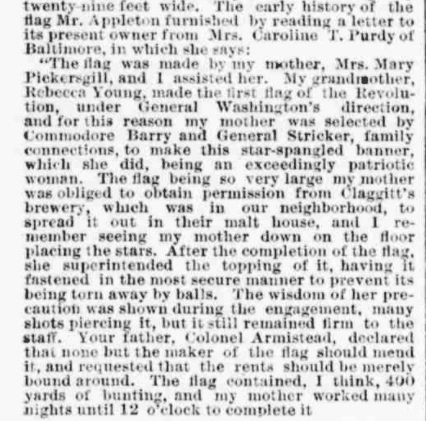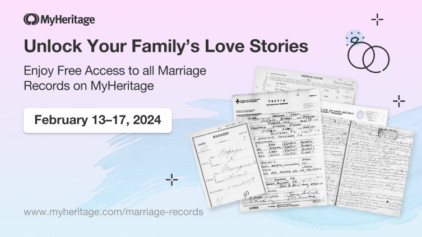The Legacy of ‘The Star-Spangled Banner’: The Anthem & the Flag That Inspired It
- By Daniella


O say can you see, by the dawn’s early light
What so proudly we hailed at the twilight’s last gleaming?
These words have been filling the hearts of United States citizens with pride, courage, and gratitude for centuries. Soldiers have sung them before rushing into battle; children have sung them, hand over heart, beside their desks at school; and the voices of thousands have joined as one to sing them at concerts, sporting events, and ceremonies.
Who wrote these powerful and evocative lyrics, and what inspired them?
The MyHeritage Research team investigated the legacy of “The Star-Spangled Banner” — and found living descendants of both the man who wrote the U.S. national anthem and the woman who made the flag it celebrates.
Francis Scott Key and ‘The Star-Spangled Banner’
Francis Scott Key was born in Terra Rubra, Frederick County (now called Carroll County), Maryland, in 1779. He became a successful lawyer and was eventually appointed U.S. attorney of the District of Columbia.
During the War of 1812, one of Francis’s friends, Dr. William Beanes, was taken prisoner by the British. Francis found the ship where his friend was being held in Chesapeake Bay, and successfully negotiated his release. However, because the men had overheard the British as they planned their imminent attack on Fort McHenry, the British refused to let them leave before the battle was fought. So Francis and William were forced to sit there and watch from behind enemy lines as their own soldiers were mercilessly bombarded by British forces for 25 hours.
“It seemed as though mother earth had opened and was vomiting shot and shell in a sheet of fire and brimstone,” Francis later wrote. As darkness fell, all he could see was “the rockets’ red glare.” Because the British attack was so forceful, he was sure he would see the Union Jack flying over Fort McHenry the next morning.
But as September 14th dawned and the smoke cleared, Frances spotted the old Stars and Stripes still raised over the fort. The sight of that flag is what inspired him to jot down the poem that later became the national anthem of the United States.
“The Star-Spangled Banner” was originally published in the Baltimore Patriot newspaper under the title “The Defense of Fort M’Henry” and contained 4 verses. It was picked up by more newspapers across the country and renamed “The Star-Spangled Banner.” Later, it was set to music, and the first verse was adopted as the U.S. national anthem on March 3, 1931.
Tracing a descendant of Francis Scott Key
The MyHeritage Research team delved into the records to locate any living descendants of Francis Scott Key.
We found Alice Pendleton, Francis Scott’s daughter, in the 1860 census, listed with her husband George, their children Frank, Jane, and Mary, and two other children, James and Alice.
James and Alice were likely the orphaned children of Philip Barton Key, also a child of Francis, who — according to a record we found — was murdered in Washington on February 27, 1859:

Article in The Boston Courier announcing the murder of Philip Barton Key. Courtesy of the MyHeritage Newspaper collections
Unfortunately, Alice herself was killed in a carriage accident in New York 7 years later, and her daughter, Jane, was seriously injured.

Article in The Boston Post about the accident that killed Alice Pendleton, daughter of Francis Scott Key. Courtesy of the MyHeritage newspaper collection
We found Jane 24 years later in the 1910 Census listed with her husband, Arthur Brice, and their children, Arthur, Alice, and Julia.
Then, we found Jane’s daughter Alice in the 1930 U.S. Census with her husband John Forsyth Joline II and their two sons, John Forsyth Joline III and Laurence T. Joline. The record states that John II was a bonds salesman in an investment company.
From there, it was just a few more steps to John III’s daughter, Helen, and her son, Eric Michael Sirois: Francis Scott Key’s direct descendant currently living in Charleston, North Carolina.
“We knew since we were children that the man who wrote the national anthem is our ancestor,” Eric told us. “My grandmother used to tell us about him, and we always felt proud… She made a handwritten family tree that showed how we are related to him. Whenever the subject came up in conversation with friends, it was always exciting to say that we are his descendants.”
“Every time I hear the national anthem I feel so proud,” he adds. “It’s neat!”
Whose broad stripes and bright stars? Mary Young Pickersgill’s
Who made the flag that Francis Scott Key saw “gallantly streaming” over the ramparts of Fort McHenry that fateful morning?
In the modern age, when we see a flag waving, we don’t give a second thought to where it came from: it was probably mass-produced at a factory somewhere. But back in 1812, all flags used in battle were hand-stitched. The flag that inspired “The Star-Spangled Banner” was sewn by a person: Mary Young Pickersgill.
Mary Young Pickersgill (possibly the one on the right) and her sister, Hannah Fearson. Photo enhanced and colorized by MyHeritage photo tools
Flag-making was apparently a tradition in Mary’s family. According to this article in The Boston Herald, published in 1932, Mary’s mother Rebecca made the first American flag to be flown in battle during the Revolutionary War.
“Tale of ‘mother’ and ‘grandmother’ of ‘star-spangled banner’ which inspired our national anthem,” reads the headline.
“Rebecca Young… made the first American flag for Washington — the Grand Union flag under which he led the army besieging the British in Boston… her daughter, Mary Young Pickersgill… made the battle flag that inspired Key to write ‘The Star-Spangled Banner,’” the article explains.
It was no small feat, either: the flag was 36 feet long.
“When the revolution ended, Rebecca Young was a widow,” the article goes on. “When the War of 1812 began, Mary was a widow too, and had a daughter of her own. The three of them were living together in a red brick house down by the waterfront in Baltimore, and it was Mary now who was the flag maker.’”
The article mentions Mary’s daughter, Caroline Purdy. We found a letter Caroline wrote to the son of Colonel Armistead, who commissioned the flag, which was published in The Boston Globe in 1877.
“The flag was made by my mother, Mrs. Mary Pickersgill, and I assisted her,” Caroline wrote. “My grandmother, Rebecca Young, made the first flag of the Revolution, under General Washington’s direction, and for this reason my mother was selected by Commodore Barry and General Stricker, family connections, to make this star-spangled banner, which she did, being an exceedingly patriotic woman.”
Caroline goes on to describe the arduous process of sewing the flag: “The flag being so very large my mother was obliged to obtain permission from Claggitt’s brewery, which was in our neighborhood, to spread it out in their malt house, and I remember seeing my mother down on the floor placing the stars. After the completion of the flag, she superintendent the topping of it, having it fastened in the most secure manner to prevent its being torn away during the engagement, many shots piercing it, but still remained form to the staff. Your father, Colonel Armistead, declared that none but the maker of the flag should mend it, and requested that the rents should be merely bound around. The flag contained, I think, 400 yards of bunting, and my mother worked many nights until 12 o’clock to complete it.”
Tracing a living descendant of Mary Young Pickersgill
Sadly, Caroline died widowed and childless. However, we were able to trace a living descendant of Mary’s sister Hannah.
First, we found Hannah’s census record from 1850. It records her living in Baltimore with her daughter, Hannah Ely, age 40, and her grandson Jesse Ely, 14. The census states that the value of their real estate was $2500, which is equal to around $86,000 in today’s currency:

Then, we found this article announcing the wedding of Jesse’s daughter, Adele Louis Ely, to Walter Scott Carswell in June 1898:

Wedding announcement of Adele Louis Ely and Walter Scott Carswell in the Baltimore American and Commercial Advertiser, 1898. Courtesy of the MyHeritage newspaper collections
In the 1910 census, we found Walter and Adele living with their children, Adele and Lois. The record states that Walter was a physician (general practice).
And that led us to Lois’s son, Jack Gilman Hinds, and then to his daughter, Grace Hinds Grinnell, who currently lives in Connecticut.
“My parents used to volunteer at the Flag House in Baltimore — which was Mary’s house,” Grace told us. “As a child I remember reciting the Pledge of Allegiance there. When I was younger I always just assumed that Auntie Mary was the equivalent to everyone’s uncle Sam, and that it was everyone’s Auntie Mary. Only when I grew up a bit more, I came to understand that it was my Auntie Mary.”
The flag Grace’s 4th-great-aunt made is currently on display at the Smithsonian Institute, and Grace says she recently took her kids to see it. “Looking at the sheer size of it made me realize what an enormous endeavour it must have been to work on that laid out on the floor of a bar, on one’s hands and knees,” she says. “It’s something I hadn’t fully appreciated when I was small.”
Grace’s ancestor’s considerable efforts paid off. Her creation went down in history as the sight that brought hope to a young lawyer from Maryland stuck behind enemy lines, and inspired him to write what would become one of the world’s best-known national anthems.
What inspiring feats did your own ancestors accomplish? Start building your family tree today and find out.

















